DEFENCE TECHNOLOGY
INTRODUCTION
“Technology has always been a force multiplier in war. For a country like India, it becomes very important because we are facing a double threat on our borders. In such a situation, it is very important for us to move forward in terms of technological advancement.”
- The history of defence technology in India is a journey that spans thousands of years, witnessing the rise and fall of empires and the evolution of military capabilities. From ancient warfare techniques to modern-day advancements, the development of defence technology has played a crucial role in shaping India’s military prowess and its position on the global stage.
- In ancient India, military techniques revolved around the use of traditional weapons such as bows and arrows, swords, spears, and chariots. The Maurya and Gupta empires showcased advanced military organization and logistics.
- During the medieval period, the advent of gunpowder and cannons brought new dimensions to warfare. The Delhi Sultanate and the Mughal Empire witnessed the incorporation of artillery and firearms in battles. The Chola Empire and the Maratha Empire also showcased formidable naval capabilities. Later, Tipu Sultan pioneered rocket technology, establishing an artillery corps and improving rockets for increased range and accuracy.
- However, the colonization of India by European powers, particularly the British, exposed the weaknesses in India’s defence technology. The advanced military technology possessed by the colonial powers, including superior firearms, artillery, and naval capabilities, gave them a significant advantage over Indian kingdoms. The Battle of Plassey (1757) and the subsequent events led to British dominance and subjugation of India.
- Post-independence, the realization of the need for a strong defence led to the establishment of institutions like the Defence Research and Development Organization (DRDO). India’s defence technology landscape has witnessed significant progress in recent times. With a focus on indigenization and self-reliance, India has made substantial advancements in various domains. The development of nuclear capabilities, missile systems, advanced fighter jets, the strengthening of naval capabilities, and the successful test of anti-satellite weapons have showcased India’s growing military prowess.
- With ongoing efforts in research, development, and strategic partnerships, India is poised to further enhance its defence technology capabilities and strengthen its position in the international arena.
Defence Technology
Defence technology refers to the application of scientific knowledge, engineering principles, and advanced systems to develop tools, equipment, and strategies that enhance a nation’s ability to protect itself and its interests from potential threats or attacks. It encompasses a wide range of areas, including missile technology, communication technology, military hardware, cyber defence systems, and other cutting-edge solutions used in the defence and security sectors.
Organizational Structure of Indian Defence
The supreme commander of the Indian defence system is the President of India.
The whole administrative control of the Armed Forces lies in the Ministry of Defence, which is responsible for formulating defence policies, budget allocation, defence acquisitions, coordinating inter-services operations, and overseeing research and development.
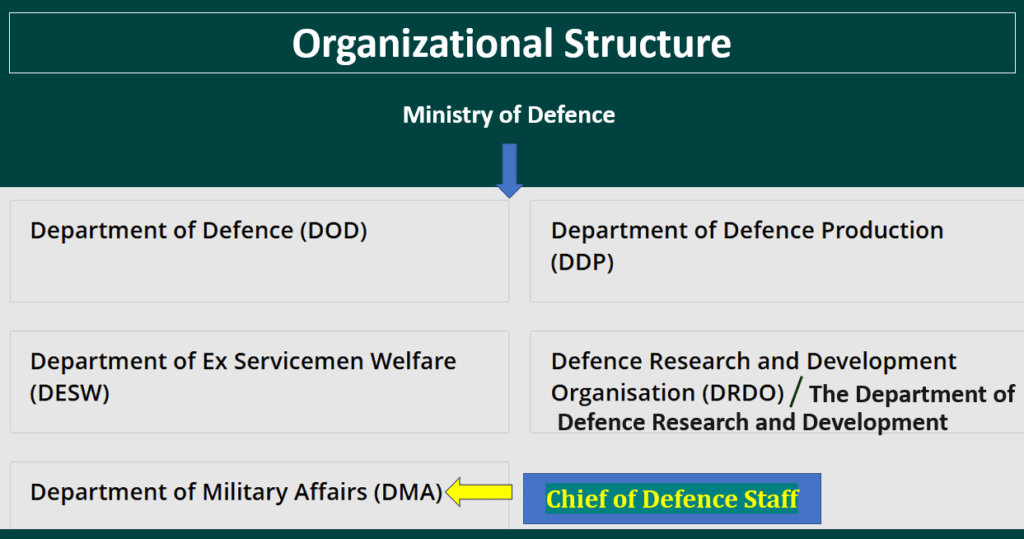
- The Department of Defence (DoD): Responsible for the Defence Budget, defence policy, matters relating to Parliament, defence co-operation with foreign countries, and coordination of all defence-related activities.
- The Department of Military Affairs (DMA): Facilitates optimal utilization of resources and promotes jointness among the three Services.
- The Chief of Defence Staff (CDS) of India is a pivotal position in the country’s defense architecture, aimed at ensuring better coordination and efficiency among the three-armed forces. The CDS is a four-star general officer and the Secretary/Head of the Department of Military Affairs. He acts as the principal military adviser to the Government and an adviser to the Nuclear Command Authority. Additionally, he serves as the permanent Chairman of the Chiefs of Staff Committee.
- The Department of Defence Production (DDP): Deals with matters pertaining to defence production, indigenisation of imported stores, equipment and spares, planning, and control of departmental production units of the Defence Public Sector Undertakings (DPSUs).
- The Department of Defence Research and Development (DDR & D): Deals with research and development of defence technologies, systems, and equipment as required by the three services of the Armed Forces (Indian Army, Indian Navy, and Indian Air Force).
- The Department of Ex-Servicemen Welfare (DESW): Deals with all resettlement, welfare, and pensionary matters of Ex-Servicemen.
DEFENCE RESEARCH AND DEVELOPMENT ORGANISATION (DRDO)
DRDO stands for Defence Research and Development Organisation. It is the premier agency under the Ministry of Defence of the Government of India, charged with the military’s research and development, headquartered in Delhi, India. It was formed in 1958. A separate department of defence research and development was formed in 1980 which later administered DRDO and its almost 52 labs that are engaged in developing defence technologies covering various fields like aeronautics, armaments, electronics, land combat engineering, life sciences, materials, missiles, and naval systems.
With a vision to empower India with cutting-edge defence technologies and a mission to achieve self-reliance in critical defence technologies and systems, DRDO has come a long way.
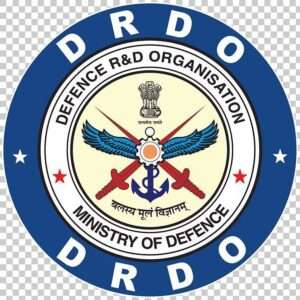
Technology Clusters of DRDO
The technology clusters of DRDO refer to specific areas of focus and expertise within the organization. These clusters represent different technological domains where DRDO conducts research, development, and innovation to meet the defence requirements of India.
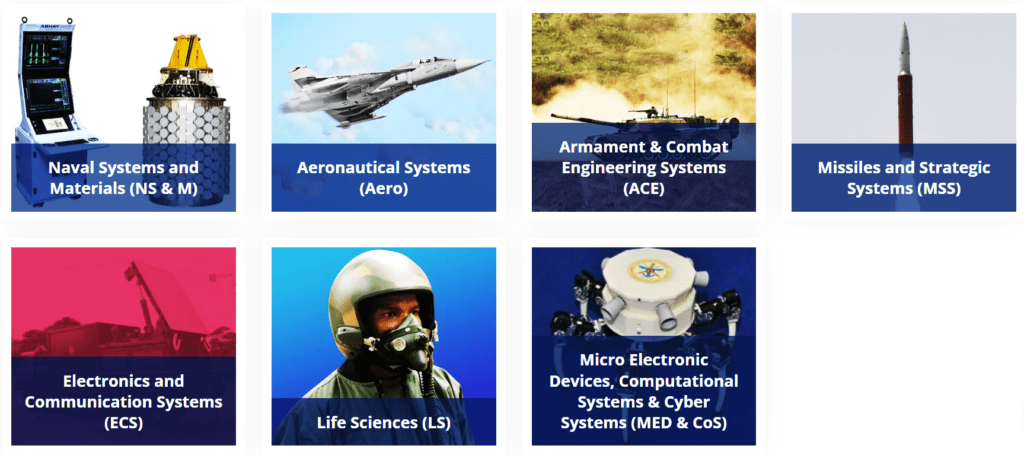
Missiles and Strategic Systems (MSS):
- MSS Cluster is responsible for the design and development of state-of-the-art missiles and strategic systems required for the deterrence and defence of the country.
- MSS cluster is working on technologies like:
- Aerodynamics and Airframe Design.
- Solid, Liquid, Ramjet, and Scramjet Propulsion.
- Navigation, Control, and Guidance Systems.
- On-board Power Supply, Warhead Systems, Launch Systems as well as the Command and Control Systems for missile systems.
Aeronautical Systems Cluster:
- This cluster focuses on the research and development of aeronautical systems, including aircraft, drones, propulsion systems, avionics, and related technologies.
- Example: Light Combat Aircraft (LCA) Tejas, Rustom, etc.
Armament and Combat Engineering Cluster:
- This cluster is dedicated to the development of armaments, combat vehicles, artillery systems, explosives, and related technologies.
- Example: Anti-Thermal, Anti-Laser Smoke Grenades.
Naval Systems and Materials Cluster:
- This cluster concentrates on naval technologies, shipbuilding, marine materials, underwater systems, sonar systems, and naval communication systems.
- Example: Maareech, an advanced torpedo defence system (ATDS), Varunastra Torpedo.
Electronics and Communication Systems Cluster:
- This cluster focuses on research and development in the field of electronics, communication systems, radar systems, electronic warfare systems, and sensors.
- Example: Divya Drishti (Electronic warfare system): It is a counter-drone system that uses sensors, radars, jammers, and lasers to detect, identify, track, and neutralize hostile drones.
Life Sciences Cluster:
- This cluster is involved in research and development related to biomedical technologies, protective equipment, medical countermeasures, and other life-science-based defence applications.
Example: Anti-Covid drug 2-deoxy-D-glucose (2-DG), RF Coils for MRI Imaging, etc. - Other examples: Black Goji Berry cultivation: It is a high-value medicinal plant that is cultivated in the trans-Himalayan region of Ladakh. It has antioxidant, anti-inflammatory, anti-diabetic, anti-cancer, and anti-aging properties.
Micro Electronic Devices, Computational Systems and Cyber Systems (Med, Cos, and Cyber Systems) Cluster:
- This emerging cluster also involves the development of technologies related to artificial intelligence (AI), machine learning, and cognitive systems. Example: Machine Learning-based Anomaly Detection System (MLADS): It is a system that uses machine learning techniques to detect anomalous or malicious activities in network traffic. It can be used for cyber defence, intrusion detection, and threat analysis.
DEFENCE ACQUISITION COUNCIL AND DEFENCE PROCUREMENT POLICY 2020
Defence Acquisition Council:
- The Defence Acquisition Council is the highest decision-making body in the Defence Ministry for deciding on new policies and capital acquisitions for the three-armed forces (Army, Navy, and Air Force) and the Indian Coast Guard.
- The Minister of Defence is the Chairman of the Council.
- It was formed after the Group of Ministers’ recommendations on ‘Reforming the National Security System’ in 2001, post-Kargil War (1999).
Defence Procurement Policy 2020:
- Defence procurement policy aims to ensure that the defence forces get the required capabilities in a timely, cost-effective, and transparent manner, while also promoting self-reliance, indigenization, and innovation in the defence sector.
- The defence procurement policy is implemented through various procedures and manuals, such as the Defence Acquisition Procedure (DAP).
- The current defence procurement policy is based on the DAP 2020. The DAP 2020 replaced the previous Defence Procurement Procedure (DPP) 2016, which was based on the recommendations of the Dhirendra Singh Committee. The DAP 2020 aims to align the defence acquisition process with the vision of ‘Aatmanirbhar Bharat’ (self-reliant India) and to empower the domestic defence industry. DAP 2020 introduces several new features and reforms, such as:
- A new category of Buy (Global-Manufacture in India) to encourage foreign original equipment manufacturers (OEMs) to set up manufacturing facilities in India through joint ventures or technology transfers.
- This policy characterizes projects on various basis:
- Make-I (Government Funded): Projects under this category will involve government funding of 70%.
- Make-II (Industry Funded): This category is for projects where the Indian industry is required to develop and produce the product and system.
- Make-III (Indigenously Manufactured): Under this category, the participation of private sector companies as well as MSMEs is intended.
- A new provision of leasing to enable acquisition of assets without owning them, thereby reducing capital expenditure and enhancing operational flexibility.
- A new procedure for acquisition of systems products and information and communication technology (ICT) systems to cater to the emerging requirements of cyber security and artificial intelligence.
- A revised offset policy to give preference to the manufacture of complete defence products over components and to provide incentives for the transfer of technology.
- One of the key features of DAP 2020 is the emphasis on indigenous defence production and self-reliance. It promotes the “Make in India” initiative by encouraging domestic defence manufacturing and reducing dependence on imports.
STRATEGIC WEAPONS OF DRDO AND RELATED PROGRAMMES
Missiles
Missiles are rocket-propelled, guided projectiles, designed to deliver an explosive warhead with great accuracy at high speed. They serve various purposes, including offensive and defensive operations, deterrence, and strategic capabilities.

Components of a Missile
Basically, a missile has four system components: targeting/guidance system, flight control system, engine/propulsion system, and warhead.
Classifications of Missile
Missiles are generally classified on the basis of their Launch Platform and Target, Use, Trajectory, Range, Speed, Propulsion, and Warhead Systems:
- On the basis of the location of the launch platform and target:
- Air-to-air – e.g. Astra
- Air-to-surface – e.g. BrahMos
- Surface-to-air – e.g. Akash
- Surface-to-surface – e.g. Prithvi, Agni
- Anti-tank/Anti-ship – e.g. Nag
- On the basis of use:
- Tactical guided missiles – i.e., missiles intended for use within the immediate battle area (e.g., Helina, Nag).
- Strategic missiles – missiles designed to strike targets far beyond the battle area (100s – 1000s of kms).
III. On the basis of trajectory:
- Ballistic trajectory (e.g., Agni Series)
- Cruise trajectory (e.g., BrahMos)
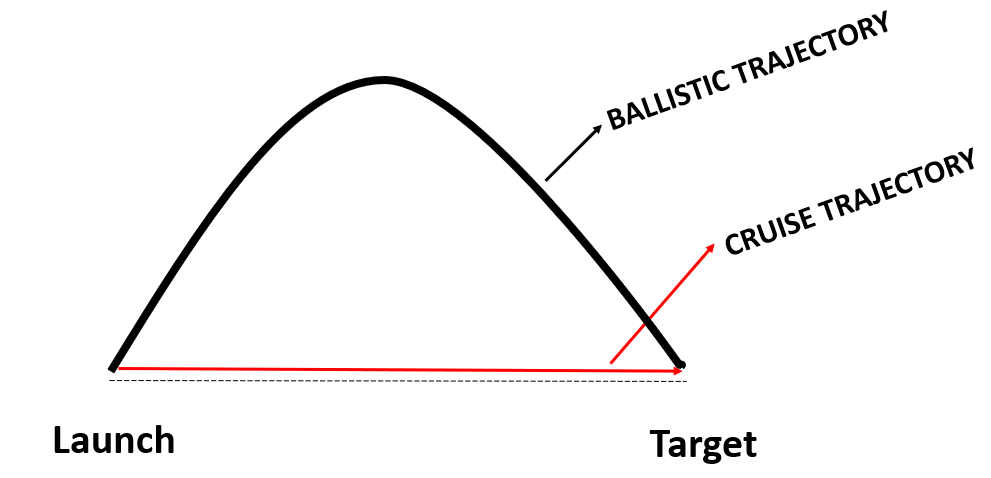
Ballistic missile
Ballistic missiles follow a ballistic trajectory, which means they are initially propelled into space (by a rocket engine or a series of rocket engines) and then fall back to Earth under the influence of gravity, motion of the Earth (Coriolis force), etc. They have the ability to carry conventional or nuclear warheads over long distances.
| Knowledge Base: Orbital and suborbital flights
· Orbital and suborbital flights are two types of spaceflights that differ in the speed and trajectory of the spacecraft. An orbital flight involves sending the vehicle into orbit around a planet, requiring very high speed to counteract the planet’s gravity. · A suborbital flight does not achieve orbit but reaches a certain height above the planet before falling back down. Suborbital flights require much lower speed than orbital flights. · Examples of orbital flights include the International Space Station, the Hubble Space Telescope, and most satellites. Some examples of suborbital flights are ballistic missiles. |
Phases of Ballistic Missiles
| Phase | Description |
| Boost phase | The rocket engine(s) fire to accelerate the missile to the speed necessary to reach its target. |
| Midcourse phase | The missile is coasting, or freefalling, towards its target. The missile may also maneuver during this phase to adjust its trajectory. |
| Terminal phase | The missile is re-entering the atmosphere and approaching its target. The missile may deploy decoys or other countermeasures during this phase to try to evade enemy defenses. |
Types of ballistic missiles based on the range:
- Short-range (Tactical) ballistic missile (SRBM): ~Range between 300 km and 1,000 km.
- Medium-range (Theatre) ballistic missile (MRBM): ~1,000 km to 3,500 km.
- Intermediate-range (Long-Range) ballistic missile (IRBM or LRBM): ~3,500 km to 5,500 km.
- Intercontinental ballistic missile (ICBM): ~5,500 km+.
Cruise Missiles (e.g., BrahMos):
Cruise missiles are self-propelled, guided missiles designed to deliver a payload, such as explosives or warheads, to a specific target. Unlike ballistic missiles, which follow a high trajectory and travel in a powered/unpowered parabolic path, cruise missiles fly at lower altitudes and are powered throughout their flight. They are typically launched from aircraft, ships, submarines, or ground-based platforms.
Cruise missiles are equipped with navigation systems, on-board computers, and sometimes global positioning systems (GPS) to guide them toward their intended target.
Types of Cruise missiles based on speed:
- Subsonic Cruise Missiles:
- A missile travels at speeds less than the speed of sound (Mach 1, approximately 343 meters per second at sea level).
- Example: Nirbhay Missile.
- Supersonic Cruise Missiles:
- A missile travels at speeds between Mach 1 and Mach 5.
- Example: BrahMos Missile.
- Hypersonic Cruise Missiles:
- These missiles travel at speeds greater than Mach 5.
- Example: 3M22 Zircon (Russia).
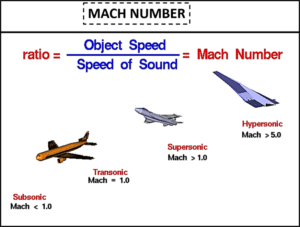
Cruise V/s Ballistic Missiles
| Category | Cruise Missiles | Ballistic Missiles |
| Trajectory | Relatively straight trajectory. | Follows a ballistic (parabolic) trajectory. |
| Launch Platforms | Can be launched from ground, air, or sea platforms. | Launched from ground or submarine platforms. |
| Atmosphere | Remain within Earth’s atmosphere. | Move out of Earth’s atmosphere and then re-enter. |
| Altitude | Fly at very low altitudes, making them difficult to detect by radar. | Operate in both atmospheric and extra-atmospheric phases. |
| Guidance | Powered and guided until they hit the target, ensuring high precision. | Powered and guided only during the initial launch phase; less precise than cruise missiles. |
| Usage | Designed for intra-continental use (shorter distances). | Used for intercontinental purposes. |
| Example | BrahMos missile. | Agni-V is an intercontinental ballistic missile. |
INDIAN MISSILES AND MISSILES PROGRAMME
One day, Dr. Kalam was walking through a park; he overheard a conversation between two defence experts sitting on a nearby bench. They were discussing the increasing threats faced by India, the over-reliance on the Soviet Union for defense, and the urgent need for advanced missile defense systems to protect the nation from potential adversaries.
Intrigued by their conversation, Dr. Kalam set out on a mission to gather the brightest minds to enable India to attain self-sufficiency in the field of missile technology.
He reached out to talented scientists, engineers, and defence strategists from DRDO, army, navy, air forces, and defence, presenting his idea of establishing an Integrated Guided Missiles Development Program (IGMDP).
Inspired by Dr. Kalam’s unwavering conviction, the team embarked on a journey filled with challenges. They faced technical obstacles, limited resources, failure, and skepticism from various quarters. However, Dr. Kalam’s leadership, determination, and infectious enthusiasm kept them motivated and focused on their goal.
One sunny day, as the sun’s golden rays bathed Indian soil, the Prithvi missile, named after the Earth goddess, took flight. It soared through the sky with steady determination, leaving onlookers in awe of India’s technological prowess and commitment to safeguarding its land and people.
Not far behind, the Agni missile, named after the goddess Agni, took flight. The Agni missile became a true embodiment of India’s ability to harness the power of fire for peaceful and strategic purposes.
Integrated Guided Missile Development Program (IGMDP)
- The Defence Research and Development Organisation (DRDO) had a number of missile programs, including Project Devil (1972) and Project Valiant (1979). These early missile programs laid the foundation for the IGMDP.
- IGMDP was the brainchild of renowned scientist Dr. APJ Abdul Kalam.
- It was intended to attain self-sufficiency in the field of missile technology.
- The IGMDP formally got the approval of the Indian government on July 26, 1983.
- It brought together the country’s scientific community, academic institutions, R&D laboratories, industries, and the three defence services in giving shape to the strategic, indigenous missile systems.
- After considering the requirements of various types of missiles by the defence forces, the program recognized the need to develop five missile systems.
Missiles Developed Under IGMDP
Short Range & Medium Range is different for surface-to-surface, surface-to-air, air-to-air missiles.
- Short-range surface-to-surface ballistic missile: Prithvi
- Intermediate-range surface-to-surface ballistic missile: Agni
- Short-range low-level surface-to-air missile: Trishul
- Short-range surface-to-air missile: Akash
- Third generation “fire and forget” anti-tank missile: Nag
- After achieving the goal of making India self-reliant in missile technology, DRDO formally announced the successful completion of IGMDP on January 8, 2008. The Agni missile was later separated from IGMDP due to its strategic importance.
IGMDP Missiles and their Specifications
| Missile | Warhead (kg) | Range | Fuel Stages |
| Prithvi-I | 1,000 | 150 km (Army, primary user) (SSBM) | Single-stage-liquid |
| Prithvi-II | 500 | 350 km (Air Force, primary user) (SSBM) | Single-stage-liquid |
| Prithvi-III | 1,000 | 350 km (Naval, primary user) (SSBM) | Two-stage solid-liquid |
| Agni-I | 1,000 | 700–1,200 km (SSBM-IRBM) | Single-stage solid |
| Agni-II | 750–1,000 | 2,000–3,500 km (MRBM-IRBM) | Two-stage solid-solid |
| Agni-III | 1,500 | 3,000–3,500 km (IRBM) | Two-stage solid-solid |
| Agni-IV | 800–1,000 | 3,500–4,000 km (IRBM) | Three-stage solid-solid-solid |
| Agni-V | 1,500 | 5,000–8,000 km (ICBM) | Three-stage solid-solid-solid |
| Agni-VI | >1,000 | 10,000–12,000 km (ICBM) | Three-stage (under development) solid-solid-solid |
| Nag | 8-10 kg warhead | 500 meters to 20 km, Third generation “fire and forget” anti-tank missile | Single-stage solid fuel |
| Akash | 60 kg warhead | 25-30 km (surface-to-air short-range supersonic missile) | Ramjet engine |
| Trishul | 5-15 kg warhead | 9-12 km (short-range surface-to-air supersonic missile) | Single-stage solid fuel |
Strategic/Tactical Missiles in The News
Agni-Prime (Nuclear Capable)
- Agni Prime (Agni “Fire”) is a new generation medium-range ballistic missile being developed by DRDO as a successor to Agni-I and Agni-II missiles, with significant upgrades such as:
-
- Composite motor casing.
- Manoeuvrable re-entry vehicle (MaRV).
- Improved propellants, navigation, and guidance systems.
- Ring Laser Gyro Inertial Navigation System (RLG-INS).
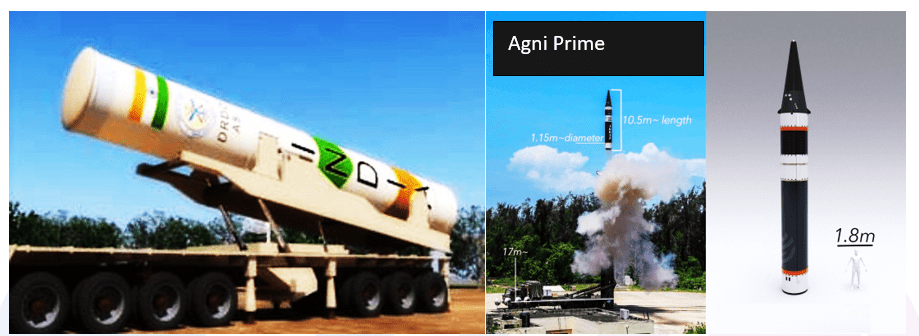
- Agni Prime has a range capability between 1,000 and 2,000 km and can carry nuclear or conventional warheads.
- It is a two-stage, surface-to-surface, road-mobile, and solid-fuelled missile transported by a truck and launched via canisterisation (canisterisation of missiles reduces the time required to launch the missile while improving its storage and mobility).
- The missile strengthens India’s credible deterrence
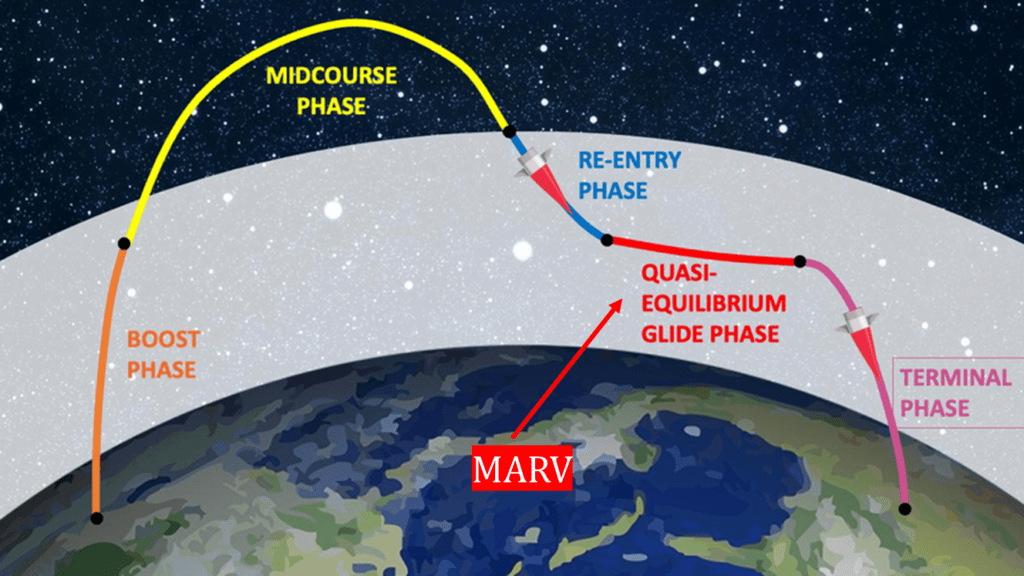
| Explainer: Inertial Navigation System
Inertial Navigation System (INS) is a navigation device that uses motion sensors to track the position and orientation of a moving object. It does not rely on external references, such as GPS, so it can be used in any environment. The main components of an INS are:
INSs are used in a wide variety of applications, including:
|
| Knowledge Base: Credible Minimum Deterrence & India’s No First Use Policy
Credible Minimum Deterrence (CMD) is India’s strategic doctrine emphasizing a minimal, survivable nuclear arsenal aimed at deterring adversaries from initiating a nuclear attack. It is based on the principles of No First Use (NFU), sufficiency, survivability, transparency, and non-use against non-nuclear weapon states. CMD aims to maintain a credible deterrent while minimizing nuclear risks and promoting global disarmament. India’s No First Use (NFU) policy states that India will not initiate the use of nuclear weapons in any conflict, emphasizing deterrence and self-defense. It aims to enhance stability, reduce the risk of nuclear escalation, and promote global disarmament. |
Agni 5: India’s First ICBM: Mission Divyastra
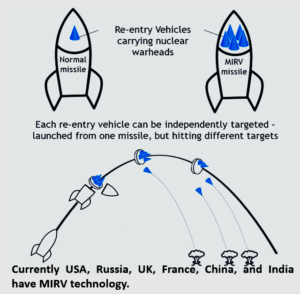
- Agni 5 missile is an intercontinental ballistic missile (ICBM). It has a range of over 5,000 km and can carry a nuclear or conventional warhead of 1.5 tonnes. It is a three-stage, solid-fuelled, road-mobile, canisterised missile that can be launched within minutes from a sealed canister on a truck or a rail launcher. It can cover the entire Chinese mainland as well as parts of Europe and Africa from its bases in central and southern India. It can also carry multiple independently targetable re-entry vehicles (MIRVs) or manoeuvrable re-entry vehicles (MaRVs) to evade enemy defences and strike multiple targets with a single missile.
- It also includes a ring laser gyro inertial navigation system (RLG-INS).
Agni 6:
- Agni 6 missile is an intercontinental ballistic missile (ICBM) that is under development by the DRDO. It is expected to be the most advanced and powerful missile in the Agni series. Agni 6 missile will have a range of 10,000 to 12,000 km and will be capable of carrying multiple independently targetable re-entry vehicles (MIRVs) as well as manoeuvrable re-entry vehicles (MaRVs).
- Agni 6 missile will be a three-stage solid-fuelled missile. It will have a launch weight of 55,000 to 70,000 kg and can carry a payload of 3 tonnes, which can include nuclear or conventional warheads.
- It will be launched from a road or rail mobile platform and guided by an inertial navigation system (RLG-INS) with NavIC satellite guidance.
Dhanush Missile:
- Dhanush missile is an Indian short-range, ship-launched ballistic missile (ShLBM) that is a naval variant of the Prithvi missile family. It is capable of carrying nuclear or conventional warheads and has a range of 250 to 400 km. It is launched from a canister mounted on a ship and guided by an inertial navigation system or Satellite Navigation System.
Prahaar Missile:
- Prahaar missile is an Indian solid-fuelled surface-to-surface guided short-range tactical ballistic missile. It is designed to provide a cost-effective, quick-reaction, all-weather, all-terrain, highly accurate battlefield support weapon system. It can carry nuclear, high-explosive, submunition, or cluster warheads and has a range of 150 km.
- Prahaar missile was developed to replace the Prithvi-I missile in Indian service and to counter the short-range ballistic missiles of Pakistan, such as Nasr.
Pralay Missile: India’s First Tactical Quasi-Ballistic Missile – for China Front
- Pralay is a new generation surface-to-surface short-range quasi-ballistic missile developed by the Defence Research and Development Organisation (DRDO). It is a canisterised missile that can be launched from a road-mobile system. It uses a solid propellant rocket engine and advanced guidance technology. It has a range of up to 500 km and can carry a warhead of 500 kg to 1,000 kg. It can perform mid-air manoeuvres using a manoeuvrable re-entry vehicle (MaRV) to evade anti-ballistic missile interceptors.
- The Pralay missile project was sanctioned in 2015 and is a derivative of the Prahaar missile

| Explainer: Quasi Ballistic Trajectory
A quasi-ballistic missile (also called a semi-ballistic missile) is a category of missile that has a low trajectory and/or is largely ballistic but can perform manoeuvres in flight or make unexpected changes in direction and range. |
Akash Missile (Akash-NG): 2021
- Akash missile (Akash-NG) is a new generation surface-to-air missile system developed by DRDO. It is a successor to the Akash and Akash-1S missiles with improvements such as a dual-pulse solid rocket motor, a canisterised launcher, and an active radar seeker. It has a range of 70-80 km and flies at supersonic speed. It can intercept high-speed and low-radar cross-section aerial threats such as fighter jets, cruise missiles, and drones. It is meant for use by the Indian Air Force.
Note: Akash missile is supported by the indigenously developed radar called Rajendra.
Akash Prime
- Akash Prime missile is a new version of the Akash missile system developed by DRDO. It is a short-medium-range, surface-to-air missile that can intercept and destroy aerial targets such as fighter jets, cruise missiles, drones, and ballistic missiles. It has a range of 27 to 30 km.
- The Akash Prime missile has some improvements, such as being equipped with an indigenous radio frequency seeker for better accuracy and reliability, enhanced propulsion, and better performance in low-temperature environments at higher altitudes. It can be deployed in mountainous regions such as Ladakh.
Helina (Army version)
- It is a helicopter-launched anti-tank guided missile (ATGM) developed by DRDO. It is a variant of the Nag missile, which is a land-based ATGM.
- Helina missile is a third-generation, fire-and-forget, lock-on-after-launch, all-weather, day and night capable ATGM that can engage and destroy enemy tanks and other armoured vehicles. It has a range of 7 to 10 km and can carry an 8 kg tandem charge high-explosive anti-tank (HEAT) warhead that can penetrate explosive reactive armour (ERA).
Dhruvastra (Indian Air Force version)
- It is a helicopter-launched anti-tank guided missile (ATGM) and a variant of the Helina missile.
- Note: The Nag, Helina, and Dhruvastra missiles use an imaging infrared seeker to lock on to the target.
Man Portable Anti-Tank Guided Missile (MPATGM)
- MPATGM is a third-generation fire-and-forget anti-tank guided missile (ATGM) developed by DRDO. It is derived from the Nag ATGM. It has a weight of 14.5 kg. It has an imaging infrared (IIR) seeker for terminal guidance. It can engage multiple targets simultaneously. It has a range of 200 to 300 for minimum range and 4km for maximum range.
SANT (Stand-off Anti-Tank Guided Missile)
- It is a fourth-generation, fire-and-forget, lock-on after launch, all-weather, day and night capable ATGM that can engage and destroy enemy tanks and other armored vehicles. It is an upgraded variant of HELINA and has a millimeter wave active radar homing seeker, which provides high precision strike capability from a safe distance. The weapon can neutralize targets up to 10 km and engage multiple targets simultaneously.
BrahMos-I
- BrahMos was named after two major rivers of India and Russia: Brahmaputra and Moskva.
- It is a joint-venture between the Russian Federation’s NPO Mashinostroeyeniya and India’s Defence Research and Development Organisation (DRDO).
- BrahMos is a medium-range ramjet supersonic cruise missile that can be launched from submarines, ships, aircraft, or land.
- It is the fastest supersonic cruise missile in the world, with a flight range of around 300 km (initially 290 km). The warhead ranges from 200 to 300 kg (both conventional and nuclear).
Note: BrahMos is a two-stage missile with a solid propellant booster engine as its first stage, which brings it to subsonic to supersonic speed. The liquid ramjet or second stage takes the missile closer to Mach 3 speed in the cruise phase.
Special Features of BrahMos:
- Stealth technology
- Advanced guidance system
- High target accuracy (irrespective of weather conditions)
- Constant supersonic speed
- Operates on a “Fire and Forget” principle
- BrahMos can be launched from land, aircraft, ships, and submarines.
- One of the heaviest missiles, weighing up to 2.5 tonnes.

| Knowledge Base: Stealth Technology
Stealth technology, also known as low observable technology, is a collection of techniques used to make aircraft, ships, submarines, and missiles less detectable (primarily to radar, infrared seekers, sonar, and other detection methods). |
- In 2016, as India became a member of the Missile Technology Control Regime (MTCR), India and Russia are now planning to jointly develop a new generation of BrahMos missiles with a 600 km to 800 km range and the ability to hit protected targets with pinpoint accuracy.
BrahMos-II Hypersonic Cruise Missile (under development)
- It is an advanced version of BrahMos I with a Speed of 7-8 Mach and a range of 600-800 km.
- It uses a Scramjet engine and is based on the fire & forget technique.
- DRDO has successfully tested a Hypersonic Technology Demonstrated Vehicle (HSTDV) in September 2020, demonstrating India’s hypersonic air-breathing scramjet technology. India is the 4th country to achieve this after China, Russia, and the US.
- In November 2024, India successfully conducted the flight test of its first long-range hypersonic missile (Range 1500 KM and 9 Mach Speed) (name is not out yet) from Dr. APJ Abdul Kalam Island. With this milestone, India joins a select group of nations—alongside the United States, Russia, and China—that possess hypersonic missile capabilities.
Astra Missile
- It is an indigenously designed and developed beyond-visual-range (BVR) air-to-air missile (AAM) by the DRDO.
- It is a solid propellant rocket capable of engaging targets at varying ranges and altitudes, allowing for engagement of both short-range targets (up to 20 km) and long-range targets (80 km to 110 km) using alternative propulsion modes.
- DRDO is planning to fit a solid fuel ducted ramjet in Astra Missile to make it more powerful.
| Explainer: SFDR Technology
Solid Fuel Ducted Ramjet (SFDR) is a missile propulsion technology that uses a solid-fueled air-breathing ramjet engine to propel the missile at supersonic speeds. It is jointly developed by India and Russia to enhance the range and performance of air-to-air and surface-to-air missiles. SFDR works on the principle of thrust modulation, meaning the thrust of the engine can be controlled by varying the flow of hot gases through a nozzle. This allows the missile to accelerate or decelerate as required by the mission. SFDR also eliminates the need for an oxidizer, reducing the weight and size of the missile.
|
K Family of Missiles
- The K family of missiles, named after Indian scientist and former president A. P. J. Abdul Kalam, is a family of submarine-launched ballistic missiles (SLBM) developed by India to boost its second-strike capabilities and augment its nuclear deterrence. The K-15 Sagarika and K-4 missiles are integrated with India’s Arihant-class nuclear-powered ballistic missile submarines (SSBNs) INS Arihant and INS Arighat.
| Missile | Type | Range | Status |
| K-15 SLBM (Sagarika) | SRBM | 750 km–1,500 km | Operational |
| K-4 SLBM | MRBM | 3,500 km | In production |
| K-5 SLBM | ICBM | 5,000–6,000 km | In development |
| K-6 SLBM | ICBM | 6,000–8,000 km | In development |
| Knowledge Base: Nuclear-capable Submarine-launched Ballistic Missile
A nuclear-capable submarine-launched ballistic missile (SLBM) is a type of missile that can be fired from a submarine and can carry a nuclear warhead to strike targets on land or sea. SLBMs are part of the nuclear triad. SLBMs also have the advantage of mobility, stealth, and survivability, as they can operate in vast oceans and avoid detection by the enemy. |
Shaurya Missile: Nuclear-capable Ballistic Missile
- Shaurya is a hypersonic surface-to-surface tactical missile.
- Shaurya, which is the land variant of India’s K-15 (Sagarika) missile, has a strike range of 700 km to 1,000 km and is capable of carrying payloads of 200 kg to 1,000 kg.
- Note: The Surya series (nuclear capable) ICBM — Surya 1 and 2 are under development.
Pinaka (DRDO)
- Pinaka is a multiple rocket launcher system developed by the DRDO of India for the Indian Army. It can fire a salvo of 12 rockets in 44 seconds and hit targets up to 75 km away. It can operate in all weather conditions.

NGARM – Rudra- M1 or M2 (DRDO)
- NGARM stands for New Generation Anti-Radiation Missile, which is a type of missile that can detect and destroy enemy radars and communication systems. It is developed by the DRDO for the Indian Air Force (IAF).
- RUDRA-M2 is an improved version with an active radar seeker and a range of 200 km.
BARAK (India + Israel): BARAK 8
- The BARAK system is a family of surface-to-air missile (SAM) systems developed collaboratively by Israel Aerospace Industries (IAI) and India’s Defence Research and Development Organisation (DRDO).
- BARAK-8 can engage multiple targets simultaneously and is adaptable for both naval and land platforms.
- It is a nuclear-capable ballistic missile designed to defend against any type of airborne threat, including aircraft, helicopters, anti-ship missiles, and UAVs, as well as cruise missiles and combat jets, with a range of up to 70 km. Both maritime and land-based versions of the system exist. Different variants of BARAK System:
- SRSAM: Range 20-30 km
- MRSAM: Range up to 70 km
- LRSAM: Range up to 100 km
QRSAM (Quick Reaction S-A-M)
- QRSAM stands for Quick Reaction Surface-to-Air Missile system, developed by the Defence Research and Development Organisation (DRDO), Bharat Electronics Limited, and Bharat Dynamics Limited for the Indian Army. It is designed to protect moving armored columns from aerial attacks, such as aircraft, helicopters, UAVs, and missiles. Range is 25 km.
Anti-satellite mission test or Asat i.e. Mission Shakti
- In March 2019, an anti-satellite missile system (ASAT) that was developed by India’s R&D organization, DRDO (Defence Research and Development Organisation), was tested to destroy a live satellite in Low Earth Orbit. The test was called Mission Shakti. With the successful Mission Shakti, India has joined the space-faring nations’ group that includes the US, Russia, and China. India is now the fourth country to demonstrate such a test successfully.
Supersonic Missile Assisted Torpedo (SMART) – to enhance anti-submarine warfare capability
- SMART is a missile-assisted release of lightweight Anti-Submarine Torpedo System for Anti-Submarine Warfare (ASW) operations far beyond torpedo range.
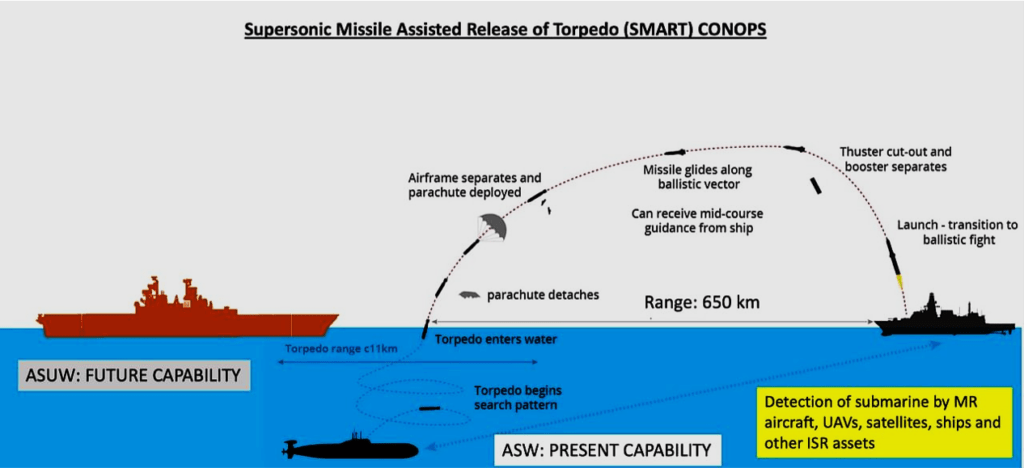
INDIA’S NUCLEAR MISSILE PROGRAMME
India has developed nuclear missiles as part of its strategy to deter potential adversaries from launching a nuclear attack. It conducted nuclear weapons tests in 1974 and 1998, confirming its status as a nuclear-armed state (not a party to the Nuclear Non-Proliferation Treaty). India’s nuclear doctrine is based on the principle of “credible minimum deterrence” and “no first use” of nuclear weapons, but it also reserves the right to retaliate with nuclear weapons in case of a major attack on its territory or forces.
The Strategic Forces Command, sometimes called Strategic Nuclear Command, forms part of India’s Nuclear Command Authority (NCA). Agni, Prithvi, and Shaurya missiles are part of it. The NCA is the authority responsible for command, control, and operational decisions regarding India’s nuclear weapons program. It comprises a Political Council headed by the Prime Minister of India and an Executive Council headed by the National Security Advisor.
Missile Defence System (MDS) in World
Missile defense is a system, weapon, or technology involved in the detection, tracking, interception, and also the destruction of attacking ballistic or cruise missiles, drones, fighter jets and other aerial targets.
Some well-Known missile defence systems in the world:
- RUSSIA:
- S-300, S-400 Triumf – other operators of S-400: India, China, Belarus, Turkey.
- S-500 (under development)
- ISRAEL:
- Iron Dome, Arrow (only Israel), David’s Sling (another operator – USA), Barak-8 – other operators: India
- USA:
- THAAD – Terminal High Altitude Area Defence. Other operators and deployments: Saudi Arabia, UAE, South Korea, Israel, Japan.
- PATRIOTS, NASAMS
- NATO:
- Medium Extended Air Defence System (MEADS)
- CHINA:
- HONG QI – 9, other operators: Pakistan
- INDIA:
- BARAK 8, Ballistic Missile Defence System (BMD), S-400, Akash Layer, Prithi Layer, Very Short-Range Air Defence System- VSHORADS
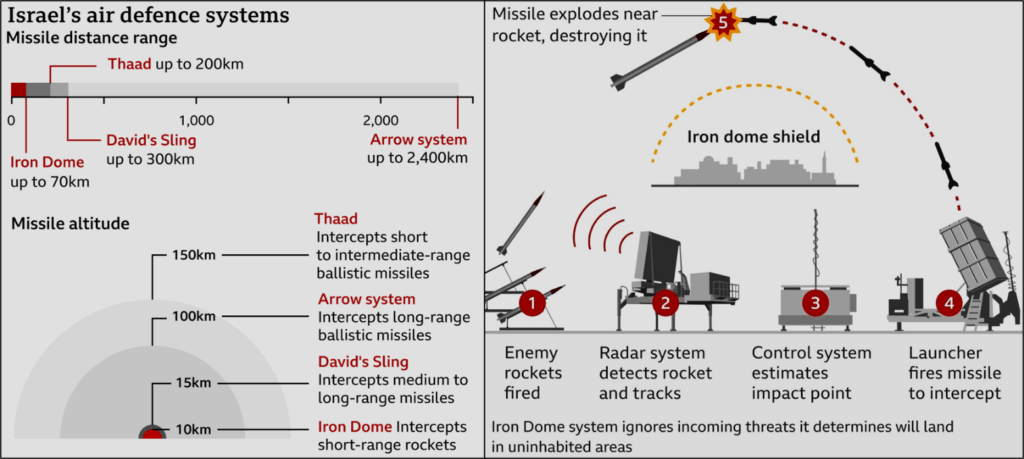
Indian Ballistic Missile Defence System or Anti-Ballistic Missile System (BMD)
The Indian Ballistic Missile Defence Programme (BMD) is an initiative to develop and deploy a multi-layered ballistic missile defence system to protect India from ballistic missile attacks. It was launched in 2000 after the Kargil War by the Atal Bihari Vajpayee government.
- The programme consists of two phases: Phase 1 and Phase 2.
- Phase 1 of the programme aims to provide protection against missiles with a range of up to 2,000 km, which is currently being deployed. It includes two types of interceptor missiles:
- Prithvi Air Defence (PAD) Missile for high-altitude interception, also referred to as Pradyumna Ballistic Missile Interceptor.
- Designed for high-altitude interception (exo-atmospheric interception). It intercepts missiles at altitudes between 50-80 km (In future, up to 50-100 km).
- Advanced Air Defence (AAD), also referred to as Ashwin Ballistic Missile Interceptor. It’s an endo-atmospheric interception system for low-altitude interception.
- Altitude of interception is up to 30 km (In future, up to 20-40 km).
- Prithvi Air Defence (PAD) Missile for high-altitude interception, also referred to as Pradyumna Ballistic Missile Interceptor.
- Phase 2 of the programme focuses on the development of anti-ballistic defence systems like the US’s Theatre High-Altitude Area Defence (THAAD) system, which can neutralize intermediate-range ballistic missiles with a range of up to 5,000 km and low-flying fighter aircraft. Phase 2 is under development and testing, and is expected to be operational by 2025.
| Recent Update: BMD: AD-1 (AIR DEFENCE Phase-II)
DRDO conducted the maiden flight test of Phase-II of the ballistic missile defence (BMD) interceptor AD-1 missile successfully in November 2022. In July 2024, the DRDO successfully flight-tested the Phase-II BMD system, which includes the AD-2 interceptor. About AD-1 and AD- 2:
|
S-400 Triumf Missile System
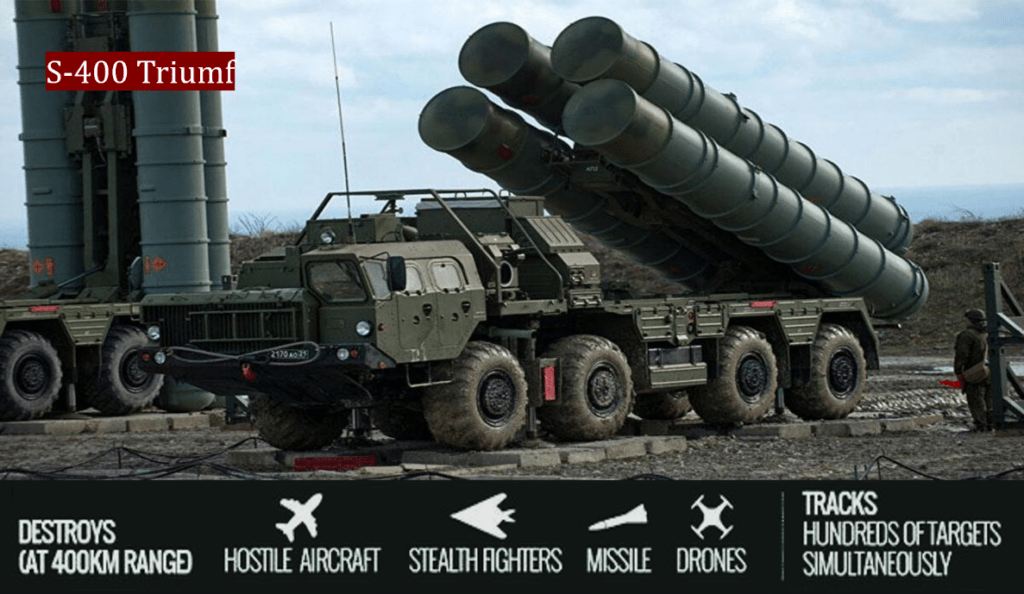
- The S-400 Triumf is a mobile, surface-to-air missile system (SAM) designed by Russia.
- It is considered one of the world’s most advanced air defence systems, much ahead of the US-developed Terminal High Altitude Area Defence (THAAD) system.
- It can simultaneously track and neutralize a range of incoming objects, spanning aircraft, missiles, and Unmanned Aerial Vehicles (UAVs). It can destroy ballistic as well as supersonic cruise missiles and has the ability to neutralize hypersonic cruise missiles.
- Each system has four different types of missiles for ranges up to 40 km, 120 km, 250 km, and 400 km. Altitude wise – 20-30 KM. It has the capability to engage 80 targets at one time with a response time of 9-10 seconds.
- THAAD cannot intercept a fighter jet, while S-400 can.
- The S-400 can be deployed within five minutes, which is faster compared to other systems.
- It has the capability to operate under intense electronic jamming environments.
Significances and Challenges in This Deal:
- It is assumed that the S-400 missile defence system being procured from Russia will make Indian airspace impregnable and its forces invulnerable.
- The system is so potent that India will be able to get insulated from Pakistani threats by just 2 or 3 units of this system. If India deploys all five units ordered from Russia, it will be able to effectively sustain a two-front war with Pakistan and China. As of March 2024, India has received three units of the S-400 system.
- Since the signing of the deal, the United States has been threatening India with its Countering America’s Adversaries Through Sanctions Act (CAATSA).
| Explainer: CAATSA
CAATSA is a law that came into effect in the US in 2017 and was meant to punish countries having deep engagements with Russia, North Korea, and Iran by using economic sanctions.
|
STRATEGIC INSTRUMENTS AND WEAPONS
Sonars (Sound Navigation and Ranging) – SONAR systems are used to detect an object underwater with the help of ultrasonic sound waves. A range of Sonar systems, to serve the Indian Navy, has been developed by DRDO, BEL (Bharat Electronics Limited), as well as the Indian Navy.
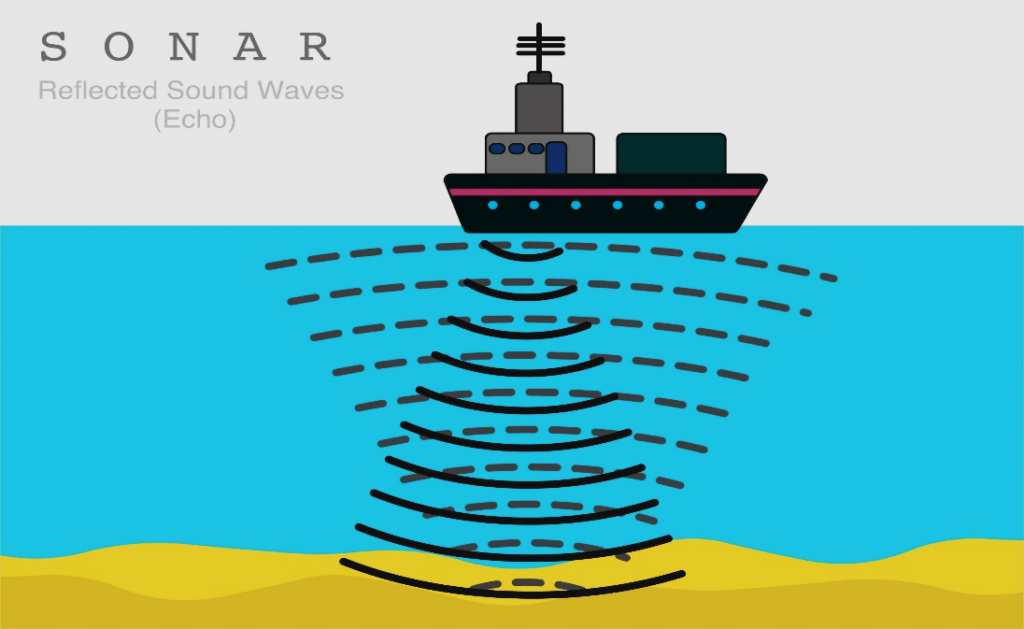
Radar (Radio Detection and Ranging)
Radar is a detection system that uses radio waves for determining the range, angle, or velocity and physical features (Size, Shape, Material, texture of an object’s surface) of objects. It can be used for detecting aircraft, ships, spacecraft, weather formations, motor vehicles, guided missiles, and terrain.
- Radar technology operates by emitting radio waves and analyzing the reflected signals that bounce back after hitting objects.
- Doppler Radar – It is a type of radar that uses radio waves to detect and measure the distance, speed, and movement of objects like raindrops or clouds. It helps to track storms, rainfall, and other weather patterns by sending radio waves that bounce back from objects (like rain or clouds) and interpreting the data.
- Doppler Effect – The Doppler effect is the change in frequency or wavelength of a wave in relation to an observer who is moving relative to the wave source.
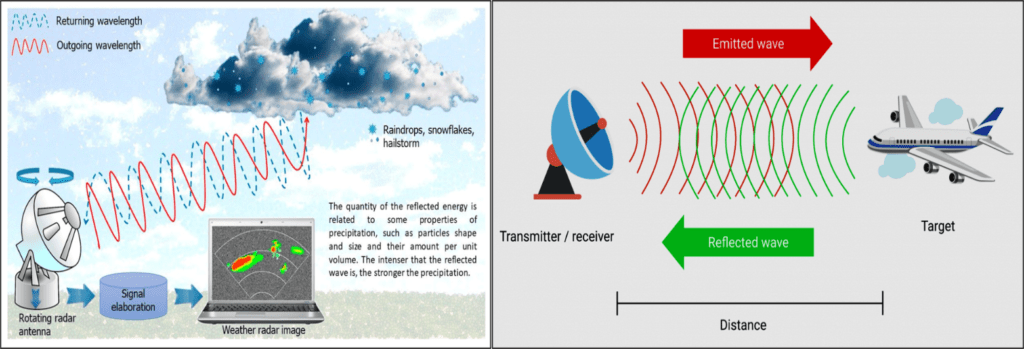
Comparison between SONAR and RADAR
| Feature | SONAR | RADAR |
| Waves Used | Sound or Ultrasound waves | Radio waves, microwaves |
| Principle | Echolocation | Reflection and scattering of electromagnetic waves |
| Applications | Underwater navigation, mapping, hydrographic surveys, search and rescue operations, oil, minerals, and gas exploration, etc. | Air traffic control, weather monitoring, military surveillance, object detection, wireless communication, guided missiles, etc. |
| Range | Works effectively underwater | Works effectively in the atmosphere |
| Speed | Slower propagation speed compared to radar | Faster propagation speed compared to sonar |
| Example | Panchendriya, Humsa, USHUS sonar system | Indra series, Rajendra Radar, Netra Airborne early warning and control system (AEW & CS), Swathi Weapon Locating Radar |
| Recent Update: Swathi Weapon Locating Radar (WLRS)
The Swathi Weapon Locating Radar (WLRS) is a radar system that can be used to find the location of enemy artillery fire. It is a mobile radar system. Jointly designed and developed by Electronics and Radar Development Establishment (LRDE), DRDO & Bharat Electronics Limited. SWATHI can detect and track incoming artillery and mortars rounds, rockets, and rocket launchers. It can simultaneously track up to 7 targets. |
AIR BREATHING ENGINES
Air breathing engines, also known as air-breathing propulsion systems, are a type of engine that relies on atmospheric air as the source of oxidizer for combustion. Unlike rockets, which carry their own oxidizer, air breathing engines utilize the oxygen present in the surrounding air to support combustion, making them more efficient for sustained propulsion.
There are several types of air breathing engines, including turbojet engines, ramjet engines, and scramjet engines. Each of these engines operates differently and is suited for specific flight regimes and speeds.
Jet Engine: Turbo Jet
Jet engines are a subset of air breathing engines that generate thrust by ejecting a fast-moving jet of heated gas, usually air, that is produced by burning fuel inside the engine. Jet engines are widely used for powering aircraft, rockets, and other vehicles that need high speed and long range.
There are different types of jet engines, depending on how the air is compressed, how the fuel is burned, and how the thrust is produced.
The Jet Engine has 3 main processes:
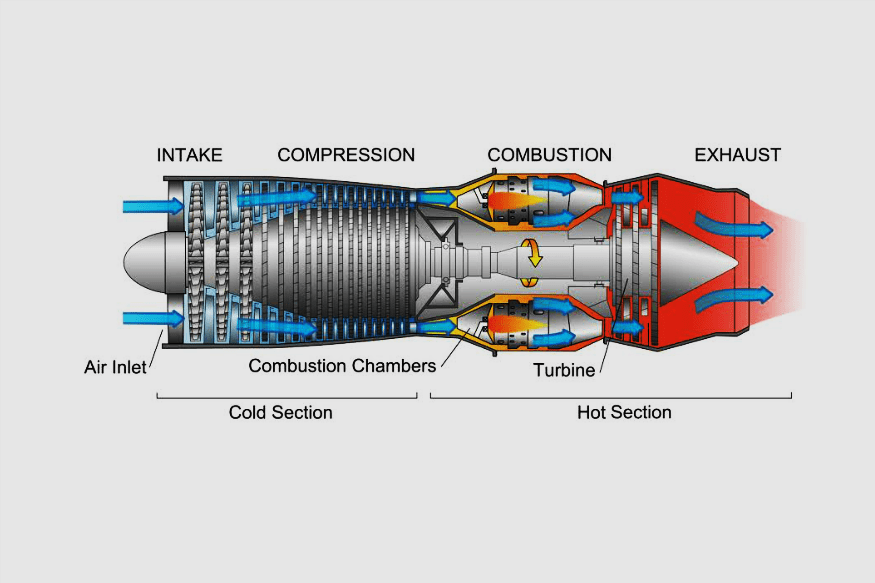
- Compression
- It increases the pressure of the air trapped inside the chamber.
- Combustion
- It increases the temperature of the air-fuel mixture by releasing heat energy from the fuel.
III. Exhaust
- It increases the velocity of the exhaust gases, thereby powering the vehicle (Newton’s third law of motion).
Advantage: Easy to make, high power-to-weight ratio.
Disadvantage: Heavy, instability during flight due to moving parts.
RAMJET
A ramjet engine is a type of air-breathing engine that operates on the principle of supersonic airflow through the engine without any rotating compressor blades. It consists of a diffuser that compresses air by the principle of ram compression (Ram Effect). A ramjet engine is used to achieve supersonic speeds. Combustion of air in the ramjet happens at subsonic speed.
- Ram effect is a physical phenomenon that occurs when a vehicle moves through the air at high speed. It creates a high-pressure zone in front of the vehicle, which compresses the air.
- Ram compression is a method of compressing air that takes advantage of the ram effect. Ram-compression engines, such as ramjets, use the speed of the vehicle to compress air without the use of traditional rotating compressors. This allows air to be compressed using the high-pressure zone created by the ram effect.
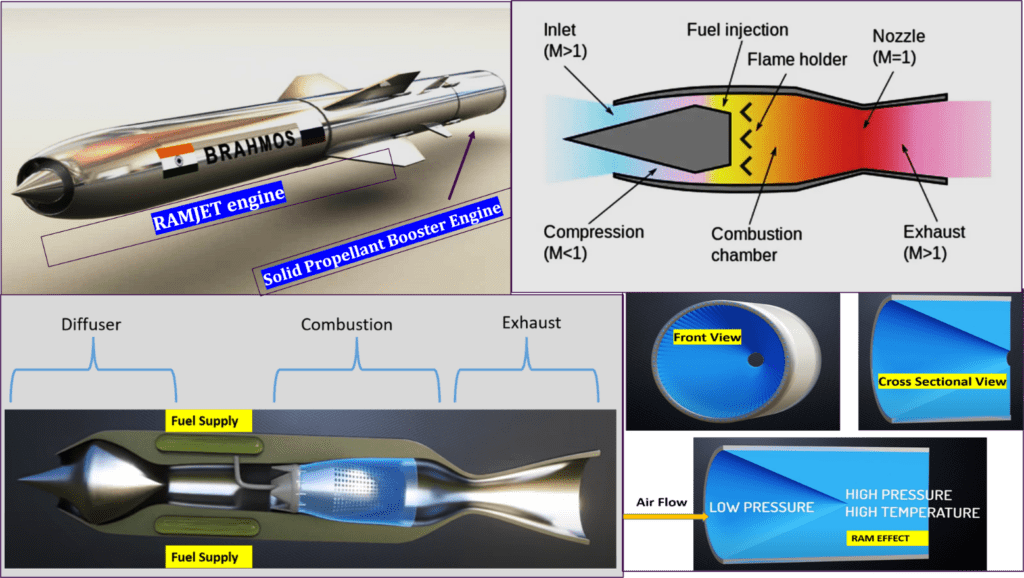
Note: Ram compression is a type of compression where the kinetic energy of the inlet air is converted into pressure energy with the help of a diffuser, thereby compressing it.
SCRAMJET
- A scramjet is a Supersonic Combusting Ramjet engine, named so because it is basically a ramjet engine where the combustion of air happens at supersonic rather than subsonic speeds.
- Its working is similar to a ramjet engine.
- Overall, scramjet engines are a promising technology with the potential to revolutionize hypersonic flight. However, there are still significant challenges that need to be overcome before they can be used in practical applications.
- RAMJET and SCRAMJET are being developed by both DRDO and ISRO.
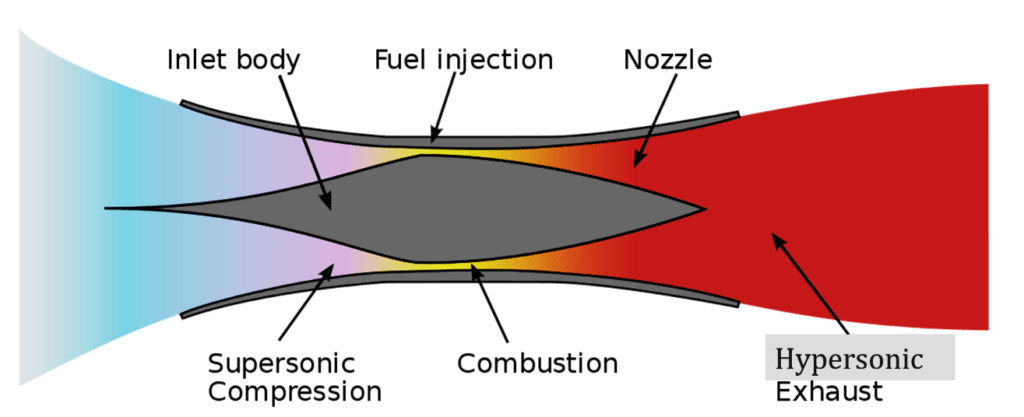
Dual Mode Ramjet (DMRJ)
- A dual mode ramjet (DMRJ) is a type of jet engine that can operate both as a ramjet and a scramjet, depending on the speed of the aircraft. This means it can operate in both subsonic and supersonic combustion modes. Dual-mode ramjets/scramjets are still in the development stage, but they have the potential to be used in a variety of applications, including hypersonic missiles and aircraft.
Advantages of Hypersonic Engine (Scramjet and Ramjet)
- Hypersonic vehicles fly faster than five times the speed of sound and can enable a new class of flight vehicles that allow faster access to space, rapid military response at long range, and faster means of commercial air travel.
- Hypersonic weapons travel within the atmosphere and can maneuver midway, which, combined with their high speeds, makes their detection and interception extremely difficult.
- This means that radars and air defenses cannot detect them until they are very close, leaving little time to react.
Types of Hypersonic Weapons
There are two main types of hypersonic weapons:
- Hypersonic glide vehicles (HGVs)
- Hypersonic cruise missiles
Hypersonic Glide Vehicles (HGVs)
- Hypersonic glide vehicles are unmanned, maneuverable vehicles that are launched into space from a rocket before gliding to a target.
Hypersonic Cruise Missiles
- They are propelled throughout their entire flight trajectory, unlike HGVs. These missiles are powered by air-breathing engines, such as scramjet engines, and are capable of sustained hypersonic speeds. These missiles follow a flatter trajectory compared to traditional ballistic missiles and can maneuver to avoid interception.
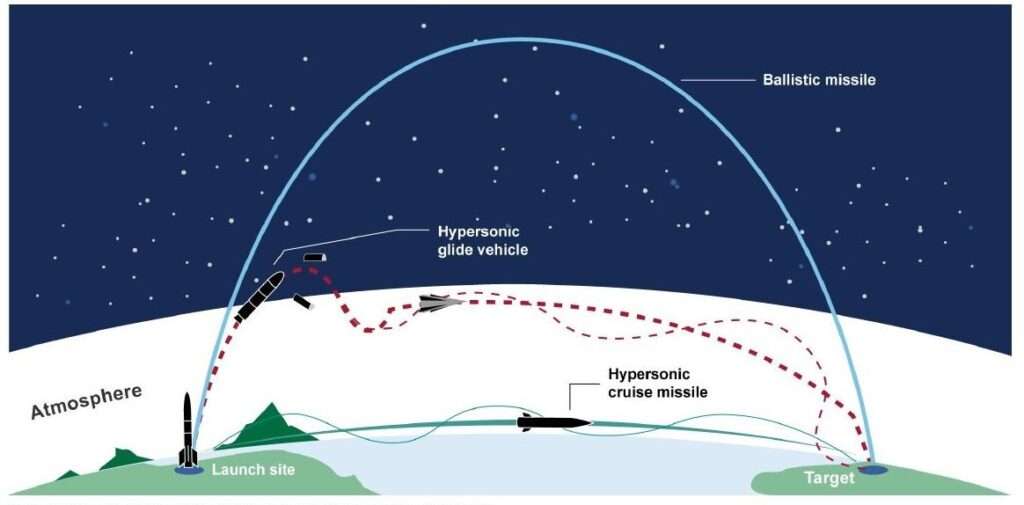
INS (Indian Naval Ship)
- The Indian Navy operates a diverse fleet of ships, each designated as INS (Indian Naval Ship), serving specific roles in maritime defense and operations. Such as – Aircraft Carriers, Submarines and Corvettes, Destroyers and Frigates, Amphibious Warfare Ships, Torpedo Launch and Recovery Vessel and more.
DESTROYER SHIPS –
- Heavily armed warships with guided missiles, designed for anti-aircraft, anti-submarine, and anti-surface warfare. Act as escorts for aircraft carriers, and protect the fleet from aerial, surface, and underwater threats.
- E.g. – INS Visakhapatnam (Project 15B), INS Kolkata (Project 15A)
FRIGATES SHIPS –
- Multi-role ships that serve in anti-submarine, anti-aircraft, and surface warfare roles. Frigates often provide protection to larger ships in the fleet and perform surveillance, reconnaissance, and rescue operations.
- E.g. INS Shivalik (Project 17), INS Nilgiri (Project 17 A)
CORVETTES SHIPS-
- Compact, maneuverable, versatile smallest class of naval ships and it falls below the warship class of a frigate- used for anti-submarine ships, coastal patrol crafts and fast attack naval vessels.
- E.g. INS Kamorta, INS Kiltan (Project 28)
AMPHIBIOUS WAREFARE SHIP-
- Designed to transport troops, vehicles, and equipment for amphibious assault operations.
- E.g. – INS Jalashwa , INS Magar
TORPEDO LAUNCH AND RECOVERY VEHICLES-
- Designed to launch and recover torpedoes, and to test underwater weapon systems.
- E.g. – INS Astradharini
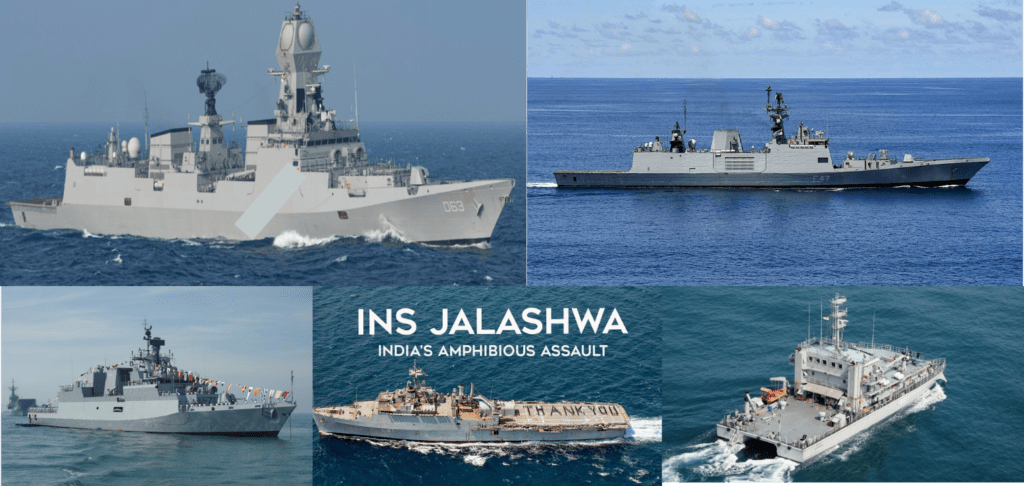
SUBMARINE
- A submarine is a watercraft capable of independent operation underwater.
- Perform crucial underwater operations, including intelligence gathering, surveillance, reconnaissance, and direct attack roles.
- E.g. INS Arihant (nuclear-powered) and INS Kalvari (diesel-electric attack submarine – Project 75 and Project 75-I)
- Submarines first became a major factor in naval warfare during World War I (1914-18) and played a larger role in World War II (1939-45).
Classification of Submarines

- Diesel-electric submarines (SSKs) use electric motors charged by diesel engines to move. These engines require air and fuel to operate, which means they need to resurface more frequently, making them easier to detect. For example, Kalvari class Scorpene.
- Nuclear-powered general-purpose attack submarine (SSNs) can stay and operate underwater almost indefinitely.
-
- They are equipped with a range of tactical weapons, such as torpedoes, anti-ship cruise missiles, and land-attack cruise missiles. For example, INS Chakra Class.
- Nuclear Powered Ballistic Missile Submarine (SSBNs) is a submarine capable of deploying submarine-launched ballistic missiles with nuclear warheads. For example, INS Arihant Class.
Present Submarine Fleet of India
- The Indian Navy currently has 16 conventional and two nuclear submarine in service. It includes:
- Seven Russian Sindhughosh Class submarines,
- Four German Shishumar Class submarines,
- Five Scorpene Class submarines, and
- Two indigenous Arihant class nuclear ballistic missile submarine (SSBNs) – INS Arihant and INS Arighat with K family Missiles.
- The Shishumar Class or HDW Class (SSKs), bought and built in India in collaboration with Germany starting in the 1980s.
- The Kilo Class or Sindhughosh Class (SSKs), bought from Russia between 1984 and 2000.
- Kalvari Class Scorpene Submarines (SSKs) (Project P-75), built at India’s Mazagon Dock in partnership with France’s Naval Group.
- INS Arihant (SSBN): India’s first indigenous nuclear-powered ballistic missile submarine. India has been developing a range of ‘K’ family SLBMs, from short- to long-range missiles that can be launched from submarines. The INS Arihant Class SSBNs are part of the Strategic Forces Command. Recently, INS Arighat, India’s second nuclear-powered ballistic missile submarine (SSBN), was commissioned into the Indian Navy.
| Explainer: AIP
What is the Air Independent Propulsion (AIP) System?
|
Knowledge Base: P-75 and P-75(I)
|
AIRCRAFT CARRIER
- An aircraft carrier is “a large ship that carries military aircraft and has a long, flat surface where they take off and land.”
- These floating air bases are equipped with a full-length flight deck capable of carrying, arming, deploying, and recovering aircraft.
- Serve as floating airbases, projecting air power far from the home territory and providing a platform for fighter jets and helicopters. E.g. – INS Vikramaditya and INS Vikrant
Aircraft Carrier in India
- INS Vikrant (UK – decommissioned): Beginning with INS Vikrant, which served India from 1961 to 1997. Played a crucial role in the 1971 war with Pakistan.
- INS Viraat (UK – decommissioned): Served the Indian Navy from 1987 to 2016.
- INS Vikramaditya:
- It is the Indian Navy’s largest aircraft carrier and warship, converted from the Russian Navy’s decommissioned Admiral Gorshkov/Baku.
- INS Vikramaditya is a modified Kiev-class aircraft carrier that was commissioned into service in November 2013 and is still operational.
INS Vikrant (New)
- India’s first indigenous aircraft carrier, INS Vikrant, is designed and built in India by Cochin Shipyard Limited (CSL) in Kerala. It has more than 76 percent indigenous content.
- INS Vikrant is named after India’s first aircraft carrier, which was acquired from the UK and played a crucial role in the 1971 war with Pakistan.
- INS Vikrant will operate MiG-29K multirole fighter jets, Ka-31 airborne early warning helicopters, MH-60R Seahawk anti-submarine warfare helicopters, and the indigenously developed Naval Tejas light combat aircraft.
- INS Vikrant is one of the two aircraft carriers in service with the Indian Navy, along with INS Vikramaditya, which was acquired from Russia in 2013.
- The Prime Minister also unveiled the new Naval Ensign ‘Nishaan’ during the commissioning of the indigenous aircraft carrier INS Vikrant.
- With the commissioning, India has joined the elite group of nations (US, Russia, France, the UK, and China) having the capability to indigenously design and build an Aircraft Carrier.
INDIA’S FIGHTER JETS AND HELICOPTERS
Multi-Role Fighter Aircraft (MRFA)
- A Multi-Role Fighter Aircraft (MRFA) is a combat aircraft that can perform different roles in combat, such as air-to-air combat, air support, aerial bombing, reconnaissance, electronic warfare, and suppression of air defenses. Some examples of MRFA are the Sukhoi Su-30MKI, Rafale, Tejas, Mig-21, Mig-29, etc.
Light Combat Aircraft (LCA)-TEJAS
- It is an Indian single-engine, 4th to 4.5th generation, multirole light fighter jet designed by the Aeronautical Development Agency (ADA) and manufactured by Hindustan Aeronautics Limited (HAL).
- The Tejas is the lightest, smallest, and tallest multirole supersonic fighter aircraft in its class. It is designed to carry a range of air-to-air, air-to-surface, precision-guided, and standoff weaponry. It has air-to-air refueling capability, a maximum payload capacity of 4,000 kg, a maximum speed of Mach 1.8, and a range of 3,000 km.
Rafale Jet
- It is a French fighter jet, manufactured by Dassault Aviation. It is a 4.5th generation fighter jet and is an “omnirole” aircraft, which means it can take on multiple missions in a single flight. The Rafale jet is a twin-engine jet aircraft. It has a top speed of 2,222 kmph or Mach 1.8.
- The Rafale jet is able to carry out all combat aviation missions: air superiority and air defense, close air support, in-depth strikes, reconnaissance, anti-ship strikes, and nuclear deterrence.
- The weapons package of Rafale jets includes Meteor missile, Scalp cruise missile, and MICA missile system. India procured 36 Rafale jets for Rs 59,000 crore in 2016.
Sukhoi SU-30MKI
- The Sukhoi Su-30MKI is a two-seater, 4.5th generation, twinjet multirole air superiority fighter developed by Russia’s Sukhoi and built under license by India’s Hindustan Aeronautics Limited (HAL) for the Indian Air Force (IAF).
- It is a variant of the Sukhoi Su-30. It is equipped with thrust vectoring control and canards, which enhance its maneuverability and agility. It also has state-of-the-art avionics which enable it to perform at high capabilities.
- It also has stahe-of-the-art avionics which enable it to perform various roles such as air-to-air combat, air support, aerial bombing, reconnaissance, electronic warfare, and suppression of air defences.
MiG-29UPG
- The MiG-29 is a twin-engine, 4th generation multirole fighter aircraft designed in Russia. In the 90s, the MiG-29 was inducted into the Indian Air Force (IAF), becoming one of the primary fighter jets in India’s fleet. The Indian Navy operates the MiG-29K, a carrier-based version of the aircraft. India has undertaken a comprehensive upgrade program for its MiG-29 fleet, resulting in the MiG-29UPG.
HELICOPTERS
Apache Helicopters
- Apache Helicopters are the most advanced multirole heavy attack helicopters in the world. Its modern capabilities include fire-and-forget, anti-tank missiles, air-to-air missiles, rockets, and other ammunition.
- It features a nose-mounted sensor suite, a 30 mm chain gun, and four hardpoints for carrying missiles and rockets.
- The IAF has signed a contract with Boeing and the US government for 22 Apache attack helicopters.
- It will replace the aging Russian Mi-35 attack helicopters in service.
HAL Dhruv
- The HAL Dhruv is a utility helicopter designed and developed by Hindustan Aeronautics Limited (HAL) in India. The indigenously designed and developed Advanced Light Helicopter (ALH-DHRUV) is a twin-engine, multirole, multi-mission new-generation helicopter in the 5.5-ton weight class.
- It can also be armed with rockets, missiles, and guns for combat missions.
- The major variants of Dhruv are classified as Dhruv Mk-I, Mk-II, Mk-III, and Mk-IV.
HAL Rudra
- The HAL Rudra, also known as ALH-WSI, is an armed version of HAL Dhruv designed and manufactured by Hindustan Aeronautics Limited (HAL).
- It is equipped with Forward Looking Infrared (FLIR) and Thermal Imaging Sights Interface.
Hal Chetak
- The HAL Chetak is a light utility helicopter built by Hindustan Aeronautics Limited (HAL) in India under a license from the French company Aérospatiale.
- The seven-seater Chetak helicopter is versatile, multi-role, multi-purpose, and spacious.
- The helicopter is suitable for commuting, cargo/material transport, casualty evacuation, Search & Rescue (SAR), Aerial Survey & Patrolling, Emergency Medical Services, Offshore operations, and underslung operations.
- The Chetak is being replaced by HAL Dhruv in the armed forces.
- HAL Chetak – Single engine
- Maximum speed – Over 210 km/h.
Hal Cheetah
- The HAL Cheetah is a light utility helicopter built by Hindustan Aeronautics Limited (HAL) in India under a license from the French company Aérospatiale. The Cheetah Helicopter is a high-performance helicopter designed for operation over a wide range of weight, the center of gravity, and altitude conditions.
- The five-seater Cheetah helicopter is versatile, multi-role, multi-purpose, highly maneuverable, and rugged in construction. It holds the world record in high altitude flying among all categories of helicopters.
MISCELLANEOUS
Torpedo
A torpedo is a self-propelled, underwater projectile that can be launched from ships, submarines, aircraft, and helicopters to attack enemy targets. The Indian Navy deploys various types of torpedoes for different roles and platforms.
- Varunastra: An advanced heavyweight anti-submarine torpedo designed and developed by the Vizag-based Naval Science and Technological Laboratory (NSTL) under the DRDO and manufactured by Bharat Dynamics Ltd (BDL).
-
- It has a maximum speed of 40 knots and a maximum operating depth of 600 meters. It has a long range with multi-maneuvering capabilities.
- It features advanced capabilities such as low drift navigational systems, acoustic homing, and autonomous guidance algorithms.
- Shyena: The first indigenous lightweight anti-submarine torpedo, developed by DRDO for the Indian Navy.
-
- It can achieve speeds of 33 knots and has a range of 19 km. It can be launched from ships, submarines, helicopters, and Ilyushin Il-38 aircraft.
- Takshak: A heavyweight anti-ship torpedo, developed by DRDO for the Indian Navy. It can achieve speeds of 50 knots and has a range of 60 km. It can be launched from submarines.
- Maareech: An advanced torpedo defence system, developed by DRDO for the Indian Navy. It consists of a towed decoy and an interceptor that can detect, divert, and destroy incoming torpedoes.
CHEMICAL WEAPONS AND BIOLOGICAL WEAPONS
Chemical and biological weapons are categories of weapons of mass destruction (WMD) that are designed to cause significant harm through the use of chemicals or biological agents.
Chemical weapons are weapons that are designed to release toxic chemicals, such as nerve agents, blister agents, choking agents, or blood agents, to harm or kill humans. These chemicals can be dispersed as gases, liquids, or aerosols.
According to Chemical Weapons Convention: Chemical Weapon Definition in Three Parts
- Toxic chemicals and their precursors
- Any munitions or devices specifically designed to inflict harm (e.g., mortars, artillery shells, missiles, bombs, mines, or spray tanks)
- Equipment directly in connection with munitions and devices

Types of Chemical Agents
- Blister agents: Sulfur mustard, nitrogen mustard, lewisite, and phosgene oxime.
- Choking agents: Chlorine, Chloropicrin, Diphosgene, Phosgene.
- Blood agents: Hydrogen cyanide, Cyanogen chloride, Arsine.
- Nerve agents: V-agents (Ve, Vg, Vm, Vx) and G-agents (tabun and sarin).
- Riot control agents: Tear Gas, Pepper Spray.
- Agent orange: A powerful herbicide and defoliant, along with Napalm, used in:
- Operation Ranch Hand (herbicidal warfare program) by the USA during the Vietnam war (1961-71).
- Used by U.K. in the Malayan Emergency (1948-60).
Biological Weapons (BWS)
- Biological weapons are either microorganisms like viruses, bacteria, fungi, or toxic substances produced by living organisms that are created and released deliberately to cause disease and death in humans, animals, or plants as an act of war.
Biological weapons are used in:
- Tactical military applications
- Political assassination
- Infection to plants or animals – leads to food insecurity and economic loss
- Creating environmental catastrophes, etc.
Historical BWS Uses → World War & Cold War
- Biological agents like anthrax, botulinum toxin, and plague pose significant public health challenges, causing large numbers of deaths in a short amount of time.
- Used in WW-I, WW-II (by Germany, UK, USA, Japan).
Types of Bioterrorism Agents
- There are three types of agents used based on the ability and extent of damage:
- Category A: High-priority agents. Example: Anthrax, Ebola virus, Coronavirus.
- Category B: Moderate-priority agents. Example: Brucellosis, Q fever.
- Category C: Low-priority agents. Example: Yellow fever virus, Hantavirus.
| Recent Update: Exercise Tarkash
Recently, India’s National Security Guard (NSG) and the United States’ Special Operations Force (SOF) conducted their sixth joint counter-terrorism exercise, Tarkash. For the first time, they carried out joint drills to handle and neutralize Chemical, Biological, Radiological, and Nuclear (CBRN) attacks. |
REGULATION OF CHEMICAL AND BIOLOGICAL WEAPONS
Geneva Protocol
The Geneva Protocol, officially known as the Protocol for the Prohibition of the Use in War of Asphyxiating, Poisonous or Other Gases, and of Bacteriological Methods of Warfare, is an international treaty that prohibits the use of chemical and biological weapons in warfare. It was adopted on June 17, 1925, and came into effect on February 8, 1928.
Biological and Toxin Weapons Convention 1972
- It is a disarmament treaty that effectively bans biological and toxin weapons by prohibiting their development, production, acquisition, transfer, stockpiling, and use.
- This agreement was signed in 1972. It came into force in 1975.
- Signatories: 109, Parties: 183
- India is a signatory of the convention.
Chemical Weapons Convention
- It was a convention on the prohibition of the development, production, and stockpiling of chemical weapons and their destruction.
- It was signed in 1993 and entered into force in 1997.
OPCW (Organization for Prohibition of Chemical Weapons)
- OPCW stands for the Organisation for the Prohibition of Chemical Weapons. It is an intergovernmental organization and the implementing body for the Chemical Weapons Convention (CWC), which entered into force on 29 April 1997.
- The OPCW, with its 193 member states, oversees the global endeavor to permanently and verifiably eliminate chemical weapons and to prevent their use or proliferation.
- The OPCW is based in The Hague, The Netherlands, and has a working relationship with the United Nations. OPCW was awarded the Nobel Peace Prize in 2013 for its extensive efforts to eliminate chemical weapons.
- India is a signatory of the convention.
Basel, Rotterdam, and Stockholm Conventions (Hazardous Chemicals and Wastes)
- The Basel (1989), Rotterdam (1998), and Stockholm (2001) conventions are multilateral environmental agreements, which share the common objective of protecting human health and the environment from hazardous chemicals and wastes.
- The Australia Group (AG – 1985) is an informal forum of countries which, through the harmonization of export controls, seeks to ensure that exports do not contribute to the development of chemical or biological weapons.
- India is a member of all.
The Chemical Weapons Convention Act, 2000
- The Chemical Weapons Convention Act, 2000 is an act of the Indian Parliament to implement the Chemical Weapons Convention (CWC).
- This act provides statutory status to the National Authority for Chemical Weapons Convention (NACWC) as the nodal agency for implementing the provisions of the CWC in India.
PREVIOUS YEAR QUESTIONS
- Consider the following statements: (2023)
Ballistic missiles are jet-propelled at subsonic speeds throughout their flights, while cruise missiles are rocket-powered only in the initial phase of flight.
2. Agni-V is a medium-range supersonic cruise missile, while BrahMos is a solid-fueled intercontinental ballistic missile.
Which of the statements given above is/are correct?
(a) 1 only
(b) 2 only
(c) Both 1 and 2
(d) Neither 1 nor 2
- Which one of the following statements best reflects the idea behind the ‘Fractional Orbital Bombardment System’ often talked about in media? (2022)
(a) A missile is launched into space to counter the asteroid approaching the Earth and explode it in space.
(b) A spacecraft lands on another planet after making several orbital motions.
(c) A missile is put into a stable orbit around the Earth and deorbits over a target on the Earth.
(d) A spacecraft moves along a comet with the same speed and places a probe on its surface.
- What is ‘Terminal High Altitude Area Defense (THAAD),’ sometimes seen in the news? (2016)
(a) An Israeli radar system
(b) India’s indigenous anti-missile program
(c) An American anti-missile system
(d) A defense collaboration between Japan and South Korea
- With reference to the ‘Organisation for the Prohibition of Chemical Weapons (OPCW),’ consider the following statements: (2016)
It is an organization of the European Union in working relation with NATO and WHO.
2. It monitors the chemical industry to prevent new weapons from emerging.
3. It provides assistance and protection to States (Parties) against chemical weapons threats.
Which of the statements given above is/are correct?
(a) Only 1
(b) Only 2 and 3
(c) Only 1 and 3
(d) 1, 2, and 3
- With reference to Agni-IV Missile, which of the following statements is/are correct? (2014)
It is a surface-to-surface missile.
2. It is fueled by liquid propellant only.
3. It can deliver one-ton nuclear warheads from about 7,500 km away.
Select the correct answer using the codes given below:
(a) Only 1
(b) Only 2 and 3
(c) Only 1 and 3
(d) 1, 2, and 3
- In the context of Indian defense, consider the following statements: (2009)
The Shaurya missile flies with a speed of more than Mach 8.
2. The range of Shaurya missile is more than 1,600 km.
Which of the statements given above is/are correct?
(a) Only 1
(b) Only 2
(c) Both 1 and 2
(d) Neither 1 nor 2
- From which one of the following did India buy the Barak anti-missile defense systems? (2008)
(a) Israel
(b) France
(c) Russia
(d) USA
- In the context of Indian defense, what is ‘Dhruv’? (2008)
(a) Aircraft-carrying warship
(b) Missile-carrying submarine
(c) Advanced light helicopter
(d) Intercontinental ballistic missile
- Consider the following aircraft: (2024)
- Rafael
- MiG-29
- Tejas MK-1
How many of the above are considered fifth-generation fighter aircraft?
(a) Only one
(b) Only two
(c) All three
(d) None
- Consider the following statements: 2009
-
- INS Sindhughosh is an aircraft carrier.
- INS Viraat is a submarine.
Which of the statements given above is/are correct?
(a) 1 only
(b) 2 only
(c) Both 1 and 2
(d) Neither 1 nor 2
- Which one of the following is the best description of ‘INS Astradharini’, that was in the news recently? 2016
(a) Amphibious warfare ship
(b) Nuclear-powered submarine
(c) Torpedo launch and recovery vessel
(d) Nuclear-powered aircraft carrier
- Consider the following activities: (2024)
- Identification of narcotics on passengers at airports or in aircraft
- Monitoring of precipitation
- Tracking the migration of animals
In how many of the above activities can the radars be used?
(a) Only one
(b) Only two
(c) All three
(d) None
PRELIMS PRACTICE QUESTIONS
- Consider the following statements regarding Project 75:
- The project aims to build six diesel-electric fueled Scorpene class attack submarines.
- The implementation of Project 75 has been facilitated through transfer of technology agreements with Russia.
- Very recently in January 2023, the fifth Scorpene class Submarine INS Vagir was commissioned.
Which among the above given statements is the correct answer:
(a) 1 and 2 only
(b) 2 and 3 only
(c) 1 and 3 only
(d) All of the above
- Consider the following pairs regarding recent procurement of Unmanned Aerial Vehicles (Drones) by Government of India:
| Drone Name | Country |
| 1. Predator Drones | United States of India |
| 2. Heron TP | Israel |
| 3. MQ-9B Sea Guardian | France |
| 4. Guardian-2 | United Kingdom |
How many of the above given pair/s is/are correctly matched?
(a) One pair only
(b) Two pairs only
(c) Three pairs only
(d) All four pairs
- Consider the following statements about Agni-Prime Missile, which was in news recently:
- It is a canisterised missile with range capability between 1,000 and 2,000 km.
- It is a surface-to-surface, two-stage solid-fueled missile.
- Agni-P is developed to achieve maximum maneuverability against missile defense systems and higher accuracy for precision strikes.
- It is considered to be a successor for Agni-V
How many of the above given statement/s is/are correct:
(a) One only
(b) Two only
(c) Three only
(d) All four of them
- Consider the following statements with respect to the comparison between Ramjet and Scramjet engines:
- In Ramjets, combustion happens at supersonic speeds, while in Scramjets, combustion happens at subsonic speeds.
- Ramjets are used in supersonic missiles, while Scramjets are used in hypersonic missiles.
- Scramjets are more efficient and they can be used to reach higher speeds than ramjets.
Which among the above given statements are correct:
(a) 1 and 2 only
(b) 2 and 3 only
(c) 1 and 3 only
(d) All of the above
- Consider the following statements regarding India’s first Anti-Satellite (A-SAT) Mission Shakti:
- The A-SAT Missile successfully engaged an Indian target satellite in Low Earth Orbit (LEO) in a ‘Hit to Kill’ mode.
- The successful conduct of Mission Shakti made India the fourth nation in the world with the capability to defend its assets in outer space.
Which among the above given statement/s is/are correct:
(a) 1 only
(b) 2 only
(c) Both 1 and 2
(d) Neither 1 nor 2
ANSWER KEY
| Question 1 | Question 2 | Question 3 | Question 4 | Question 5 |
| d | c | c | b | a |
| Question 6 | Question 7 | Question 8 | Question 9 | Question 10 |
| a | a | c | d | d |
| Question 11 | Question 12 | |||
| c | b | |||
| Question 1 | Question 2 | Question 3 | Question 4 | Question 5 |
| c | c | c | b | c |
MAINS PREVIOUS YEARS QUESTIONS
- How is S-400 air defence system technically superior to any other system presently available in the world? (Answer in 150 words) 10 – 2021
MAINS PRACTICE QUESTIONS
- What do you understand by a Ballistic Missile Defence System? While discussing the key components of the Indian ballistic missile defence system, compare it with other key defence systems across the world. (250 words)
- What are the unique specifications which make Brahmos technically superior to other similar strategic weapons? How are Indian national objectives of defence trade and security being served with the Brahmos missile system? (250 words)
- Discuss the Indian Integrated Guided Missile Development Programme (IGMDP), emphasizing its inception, key developments, and strategic significance. (150 words)
